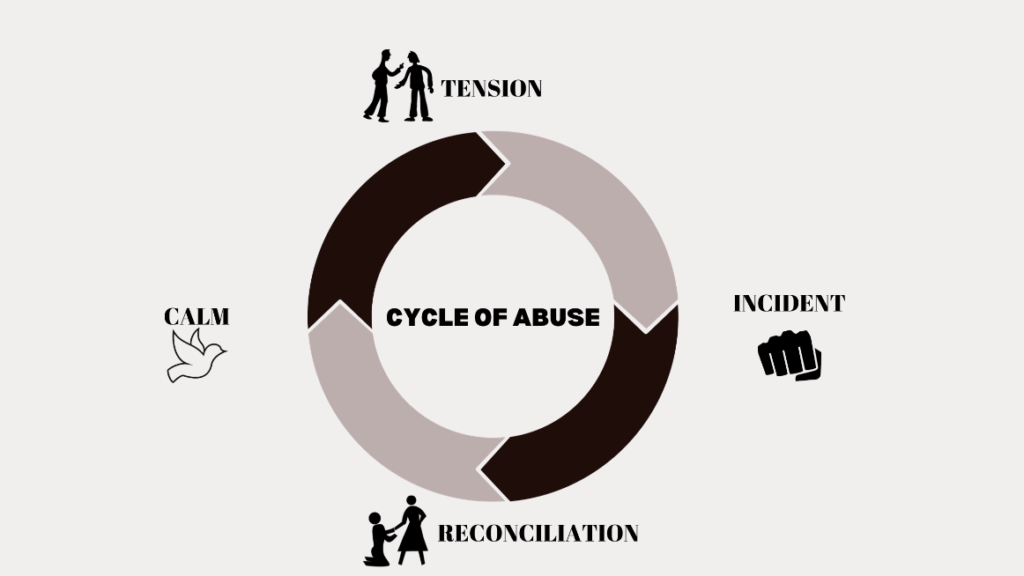
Abuse is a pattern of behavior or actions in which one person uses power, control, or authority to harm, intimidate, manipulate, or exploit another person physically, emotionally, sexually, or psychologically.
Domestic violence is a pattern of abusive behavior within a family or intimate relationship, where one person seeks to gain and maintain power and control over another. It encompasses a wide range of abusive behaviors and can have severe physical, emotional, psychological, and social consequences.
Here are some common types of domestic violence:
Verbal Abuse
is a common and destructive form of domestic abuse that relies on the use of harsh and hurtful words to control and manipulate a victim.
- Name-Calling: The abuser uses derogatory and insulting names to demean the victim.
- Yelling and Shouting: Yelling and screaming are used to intimidate and instill fear in the victim.
- Silent Treatment: The abuser uses silence as a weapon, refusing to communicate or acknowledge the victim for extended periods, causing emotional distress.
- Gaslighting: Manipulating the victim’s perception of reality, making them doubt their own memory, feelings, and sanity.
- Scapegoating: The victim is blamed for the abuser’s frustrations and problems, even if they have no connection to the issues at hand.
Physical Abuse
Physical abuse involves the use of physical force or violence to control and harm another person within a family or intimate relationship.
- Slapping and Smacking
- Pushing and Shoving
- Hair-Pulling
- Throwing Objects
- Use of Weapons
Sexual Abuse
is a distressing form of abuse that involves non-consensual sexual activity, coercion, or exploitation of another person.
- Rape
- Forcing unwanted sexual acts
- Forced Pornography
Emotional Abuse
involves the use of various manipulative tactics to control, degrade, or harm another person emotionally and psychologically.
- Isolation: The abuser isolates the victim from friends and family, making them feel entirely dependent on the abuser.
- Emotional Blackmail: Manipulating the victim through guilt, fear, or threats to get them to comply with the abuser’s demands.
- Constant Criticism: The abuser consistently criticizes and belittles the victim, attacking their self-esteem and self-worth.
- Verbal Insults: Using derogatory and insulting language to demean the victim and make them feel inferior.
- Withholding Affection: The abuser withholds love, affection, or emotional support as a means of control.
THE CYCLE OF ABUSE
All person experiences abuse differently and under different circumstances. Abusive behaviors may vary even within the same relationship, and in certain situations, they may seem to end before they reappear. This is commonly known as the abuse cycle. It is a model that helps explain the pattern of behavior typically seen in abusive relationships.
The cycle of abuse or cycle of violence was originally introduced by psychologist Lenore E. Walker in the 1970s. After conducting in-depth research and interviews with women who had been subjected to abuse and domestic violence, she came up with the stages of the cycle of abuse that are usually recorded in an abusive relationship.
Stage 1: Tension Building
This phase is characterized by increasing tension and conflict between the partners. The abuser may become irritable, moody, and easily frustrated. The victim often tries to “walk on eggshells” to avoid triggering the abuser’s anger or outbursts. Communication and emotional intimacy break down during this phase, leaving the victim feeling anxious.
Stage 2: Incident of Violence
This is the explosive phase where the actual abuse occurs. The abuser’s anger and aggression peak, leading to physical, emotional, or verbal violence. Here the abusive partner attempts to overtly regain a sense of power and control. An abusive incident may look different every time or from relationship to relationship
.
Stage 3: Reconciliation
Also called the Honeymoon phase. This occurs usually some time after the abuse and the tension has decreased the abuser typically expresses remorse and guilt. They may apologize, promise to change, and offer affection, gifts, or other signs of love and kindness. The victim often wants to believe that the abuser has changed and may hope for a better future. This reconciliation phase ends as soon as small incidents begin again.
Stage 4: Calm
During the calm stage, both parties usually come up with some excuse or explanation for the abuse to maintain harmony in the relationship. The abusive partner might apologize while blaming others or external factors to justify their behavior they might even minimize the abuse or deny it happened while accusing the victim of provoking them.
In addition to relieving some of the tension surrounding the incident, the victim may conclude that it wasn’t as horrible as they initially thought. In the end, the abuser will trick the victim into believing that the abusive behavior is no longer present even though it isn’t.
How to Break the Cycle of Abuse
Breaking the cycle of abuse is a challenging task to do, especially if your partner has convinced you that you are to blame for it to begin in the first place. The first step is always to acknowledge that you are in an abusive situation. This can be emotional, physical, or any form of abuse. Many victims often deny or minimize the abuse, which can make it challenging to break the cycle.
Reach out to trusted friends, family members, or professionals who can provide emotional support and guidance. This support network can help you gain the strength to leave an abusive relationship. Breaking the cycle of abuse is challenging, and it may take time. The most important thing is your safety and well-being. Seek professional help, and legal action, if necessary, reach out to support networks, and take steps to protect yourself from further harm. You don’t have to go through it alone, and there are resources available to assist you in this journey.
The End Note
The “cycle of violence” model has been criticized for oversimplifying complex dynamics and for not considering the variations in abusive relationships. It’s essential to recognize that not all abusive relationships follow this exact pattern, and each situation can be unique. However, this model has been valuable in raising awareness about the repetitive nature of abusive relationships and the need for support and intervention to break the cycle of abuse.
Blog By : DEEBHA SITHTA

